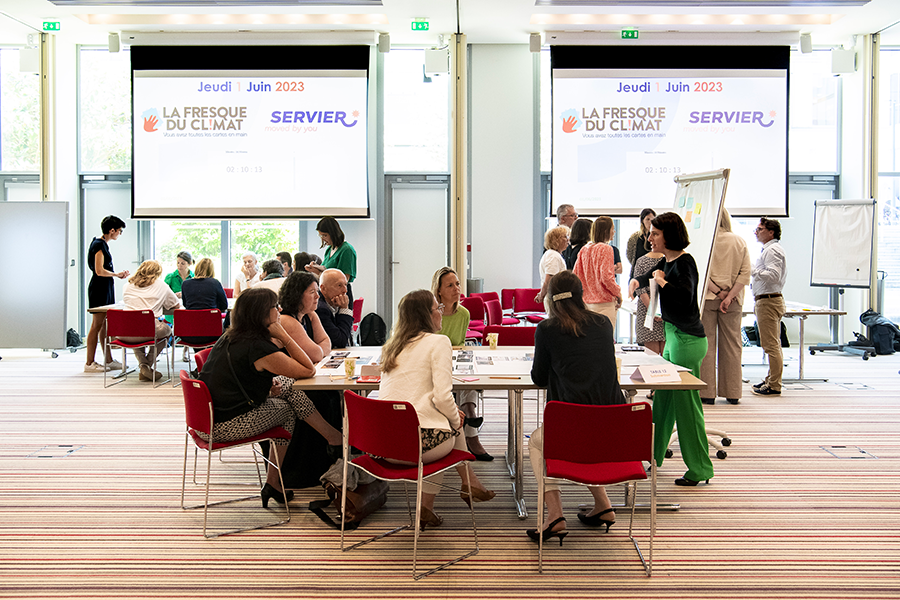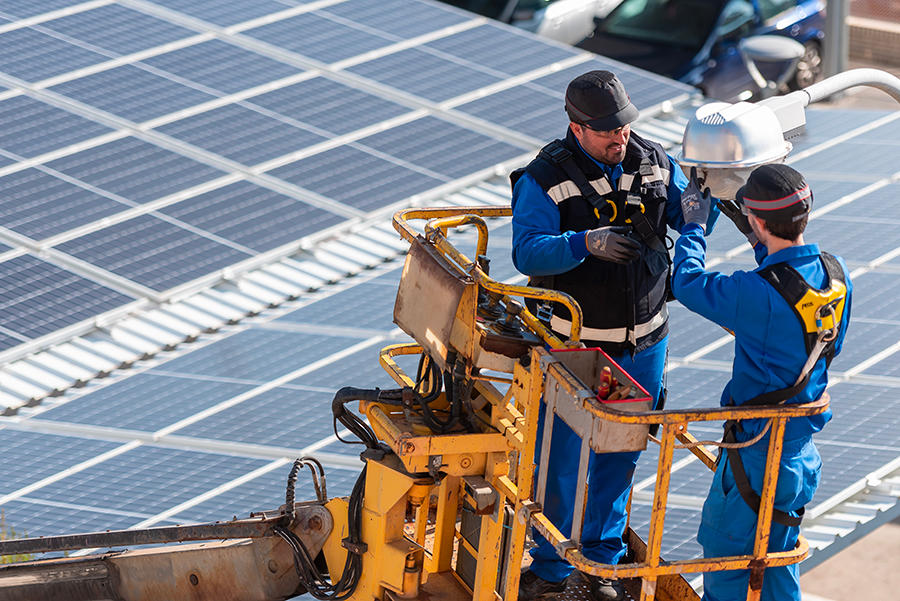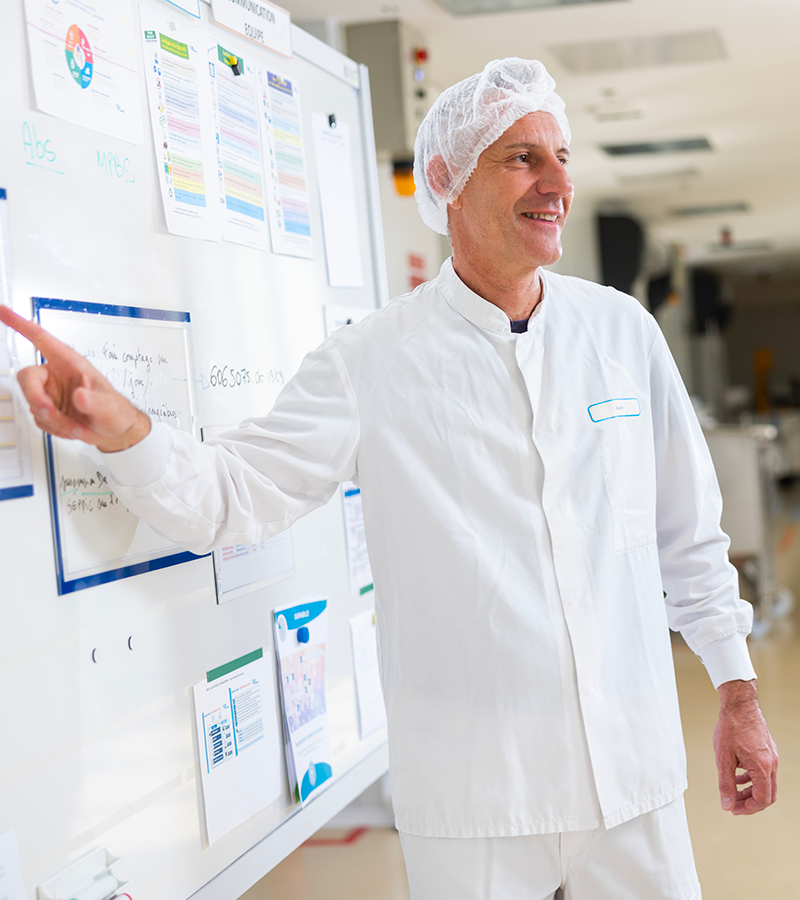
Fostering a healthy environment
for the planet
We are determined to make firm commitments to protect the planet
A healthy environment is indispensable for good health. That is why at Servier, we endeavor to address climate change and the degradation of our environment. Our efforts to reduce greenhouse gas emissions, protect biodiversity and preserve natural resources are woven into every stage of the medicine life cycle. By protecting the health of the planet, we inevitably protect human health.
Servier Climate School
To effectively tackle environmental challenges, we must first understand them. That is why we launched the Servier Climate School in September 2023. The school offers accessible scientific and educational content (quizzes, videos and interactive lessons) to help employees better understand the environmental challenges and the impact they have on society and our operations. They offer an insight into the ways in which everyone can make a difference, both in their personal and professional lives.

Climate focus
We have set targets to cut greenhouse gas emissions and developed a low-carbon strategy in energy, mobility, procurement of goods and services, as well as the distribution of our medicines. Our various departments strive to adapt and implement their own road maps to reflect these priorities.
An ever-more ambitious commitment
We aim to achieve:
42%
reduction in CO2 emissions across scopes 1 and 2 by 2030 compared to 2021-2022
25%
reduction in CO2 emissions across scope 3 by 2030 compared to 2021-2022
Aligned with the objectives set out in the Paris Agreement, the new trajectory will be approved in 2024 by the SBTi, the international body setting the benchmark in terms of corporate action on climate.
Note : Scope 1 emissions occur directly from sources that are controlled or owned by the Group. Scope 2 emissions are associated with the purchase of electricity, steam, heat, or cooling. Scope 3 emissions include greenhouse gas emissions that are not directly related to producing the product but are caused instead by other stages of the medicine life cycle.
Where we are with our carbon footprint
– 11%
Reduction in scope 1 & 2 greenhous gas emissions in 2022-2023 as compared to the previous year
We take action in four key areas to achieve our objectives:
Year on year, we increase the proportion of renewable energy in our overall energy mix. Currently, half of our industrial facilities are equipped with photovoltaic panels that generate renewable electricity directly on site. Overall, four industrial facilities are fully self-sufficient in renewable electricity (Arklow in Ireland, Toledo in Spain, and Jacarepagua and Pharlab in Brazil) as is our research center in Budapest, Hungary.
13%
Proportion of renewable electricity in our energy mix
-15 %
energy consumption in 2022-2023 as compared to the previous year

50%
of our industrial facilities are certified ISO 50001 or 14001 (Oril and Gidy in France, Arklow in Ireland, Anpharm in Poland, Toledo in Spain, Cairo in Egypt, Sophyno in Russia and Tianjin in China)
15%
In 2022-2023, our energy consumption was reduced by 15%, as compared to the previous year.
In our promotional subsidiaries in Belgium and Luxembourg, the new catalogue presents electric vehicles only. As we transition to an electric vehicle fleet, we are also installing charging points at our facilities, and conducting a feasibility study regarding the installation of solar panels in order to power these charging points.
We require the suppliers involved with our brand-name medicine business to provide information regarding greenhouse gas emissions and systematically integrate climate data in assessments of companies responding to calls for tender.
In 2022/2023, 57% of the Group’s intercontinental shipments went by sea, and 43% by air. Compared with last year, this represents a significant increase in the proportion of sea freight and a significant reduction in air freight.
Compensating our residual emissions
At the same time, we are pursuing a plan to offset a portion of our residual emissions through two greenhouse gas avoidance projects. By 2025, the aim is to reach 58,000 tons of CO2 equivalent per year.
Positioning biodiversity and nature at the heart of our efforts
In 2021, we once again underscored our commitment to protecting biodiversity and nature when we signed up to the Act4nature international initiative led by EpE (Entreprises pour l’Environnement).
We have signed up to the ten commitments set out by the initiative, to which we have added our own:
-14%
Our water consumption fell by nearly 14% between 2021-2022 and 2022-2023, which represents a saving of 178,058 m3.
With respect to our Act4Nature pledge:
We finance reforestation and biodiversity restoration projects in Brazil, Madagascar, and Indonesia (Floresta de Portel, TAPIA and MERCI).
Our new Research and Development Institute in Paris-Saclay offers a concrete example of our pioneering ambition with respect to biodiversity, as it obtained the international BiodiverCity® label, which attests a level of excellence regarding ecology and sustainable construction. By 2030, we aim to have earned the BiodiverCity Life label, or an equivalent certification, at 100% of our facilities in France.
Harnessing ecodesign to drive progress
Throughout the entire medicine value chain (from the R&D phase through to the product end of life, and including raw material procurement, manufacturing, logistics, distribution and use), we see ecodesign as a key way to drive progress. We aim to reduce the impact of our operations on the environment while constantly maintaining efficacy and therapeutic safety standards.
The ecodesign program

Our Green Score tool seeks to integrate the principles of green chemistry and ecodesign in synthetic substance activities for our medicines. It is currently being deployed and will enable us to assess the environmental impact of 100% of our new industrial chemical synthetic substances.
By 2030, 100% of our brand-name medicines will integrate an ecodesign approach.
In order to encourage more environmentally friendly choices, our industrial facilities are putting together packaging recommendations for our packaging design partners.